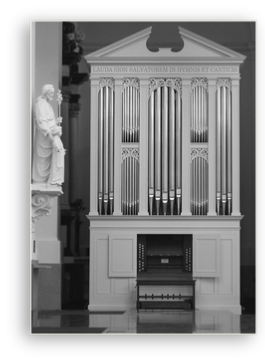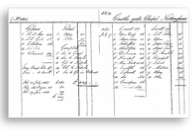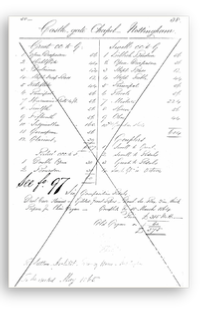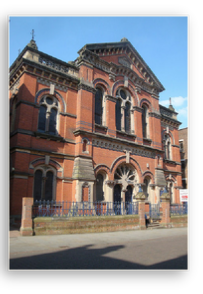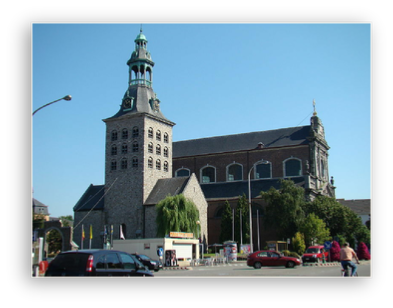Swell to Great, Swell to Great in Octaves, Swell to Choir,
Great to Pedal, Swell to Pedal, Choir to Pedal, Pedal Octave
4 Composition Pedals to Great, 2 Comp. Pedals to Swell
Pitch: 448 Hz
Wind pressure: 76,2 mm Wk (3 inch)
On the 23rd of November 2012, this restored Forster & Andrews-organ
was inaugurated. The organ was built by Forster & Andrews in 1865,
for the Castle Gate Chapel in Nottingham. In Harelbeke it was
provided with a new neoclassical case.
The St. Salvatorchurch is a spacious, classicistic church, which was built
between 1769 and 1773.The church was built on a grand scale, as the ancestors of the Counts of Flanders were buried there. In 2009 the interior was fully restored, and as its final piece, the restored organ was placed in the transept, in front of the "Heilige-Doornkapel" (holy thorn-chapel).
Initially, the instrument is mentioned in the Forster & Andrews order book as a large, 2-manual instrument, with the annotation: prepared for Choir. During the build however, the Choir was added anyway. The Clarinet, which had been prepared on the Great, moved to the Choir. The open space on the Great remained empty.
In 1894, the work was done by Cousans from Lincoln. On that occasion, the manual coupler Swell to Choir was probably added, as was the Pedal Octave coupler. The tremulant (signed by him) was also placed by him. In 1908 it was decided to buy a larger organ (a 4-manual Binns organ with 35 stops), and to donate the Forster & Andrews-organ to Hyson Green United Reformed Church. The Mixture of the Great and the Cornopean were removed, possibly by Loyd of Nottingham, who dealt with the move. In 2000, the instrument was offered for sale in an almost unplayable state, and ended up in our storage facility.
During the recent restoration, the later changes in the stoplist have been reversed, and the pipe work has been supplemented with suitable historical pipe work from stock. The non-original Horn in the Swell moved to the Great; the pipe work had the makings and inscriptions of a Cornopean. A used reed by Conacher was placed on the Swell, in the Horn’s position. The Oboe, which was probably not original, was preserved. A Clarion 4 ft was placed in the empty space on the Great, where the Clarinet had once been planned. The missing Mixture 3 ranks was reconstructed with the help of pipe work from stock. On studying the rack boards, it appeared that the composition must have been identical to the three highest choirs of the Mixture 4 rks of the Swell. It seems to be an accurate conclusion that the Sesquialtra III (a tierce-mixture) from the original plans was never placed, but that is was decided during the build to place a quint-mixture. Looking at other F & A dispositions from the time of the build, it is clear that the Sesquialtra disappears around this time. The stop-plate (with the words Mixture 3 rks) also seems original.
To replace the lost Lieblich Flöte 4 ft of the Choir, a Flute by F & A from the same year was found (from the organ of the Free Reformed Church in Aduard).
The instrument has a strong and clear sound, as is usual with instruments by these builders. Their instruments remained notably classical, until late in the 19th century, in contrast to the work of other English builders. Forster & Andrews were strongly influenced by the German organ builders of the day, especially by Edmund Schultze, who built an elaborate instrument in Doncaster Cathedral (1862). In the stoplist as well as in the voicing, this (German) influence is clearly apparent.
Laurence Elvin describes in his book: “Forster and Andrews Organ Builders 1843-1956”, how they organized a concert in the erecting hall of the company in Hull, in 1865.
"On one occasion during 1865 the large erecting hall and gallery was full and upwards of two hundred folk heard Mr. Skelton (Organist of Holy Trinity, Hull) and Mr. Andrews demonstrate an organ intended for Castlegate Congregational Church, Nottingham. Andrews was an organist of no mean ability and sometimes opened the firm's new organs."
The organ that was demonstrated in the hall at
that instance was evidently the organ from
Harelbeek!
When the instrument was inaugurated use on
the 23rd of November, it was played by
Nico Ronsse (the organist of the St. Salvator
church), and by Sietze de Vries.




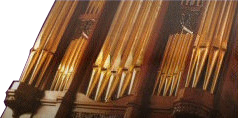
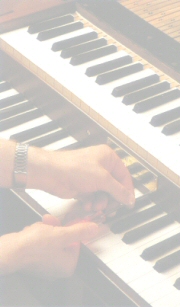 Contact
Recordings
Previous page
Contact
Recordings
Previous page
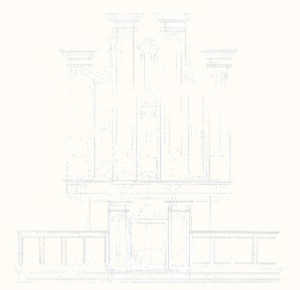




 Previous page
Previous page







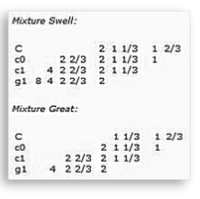 Back to top
Back to top
